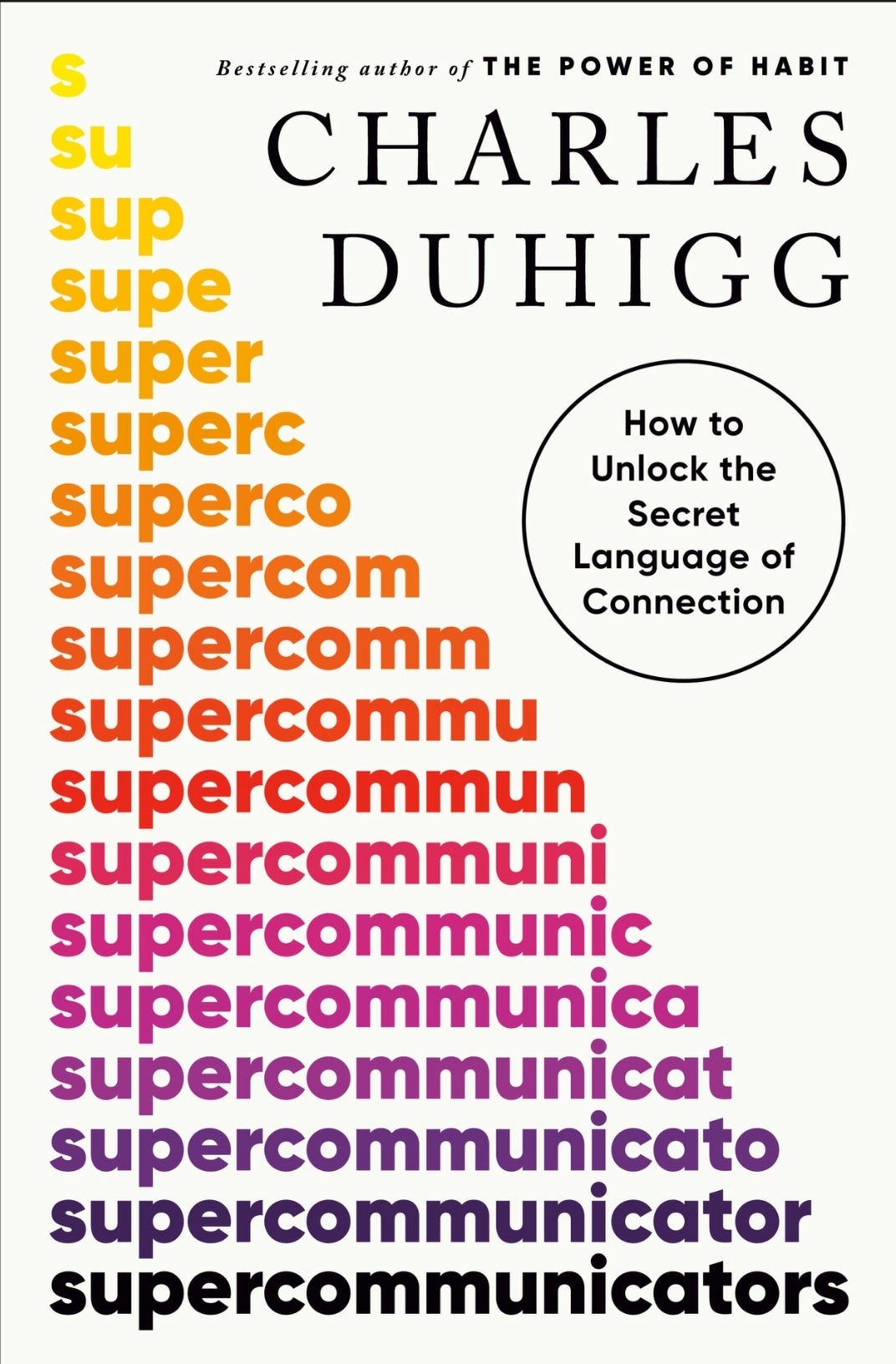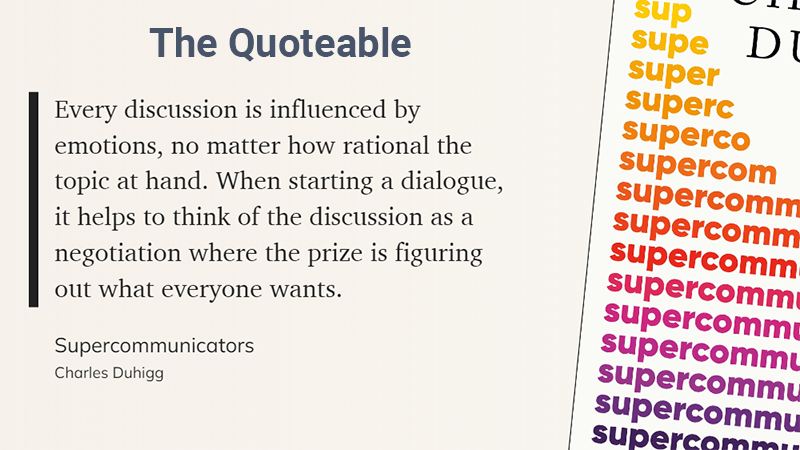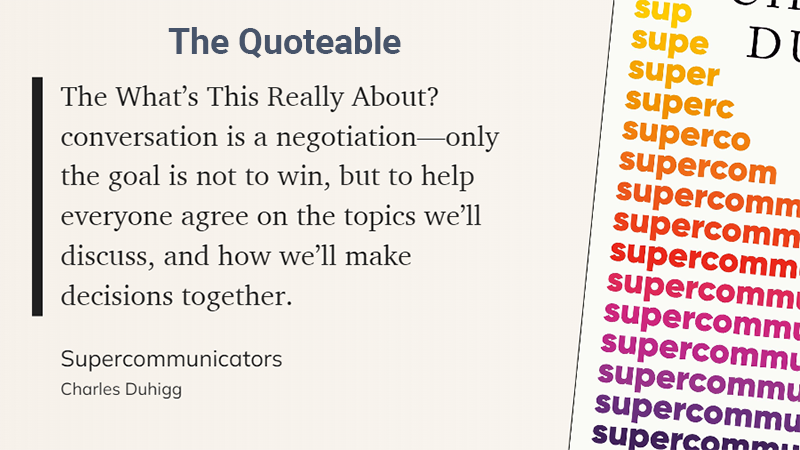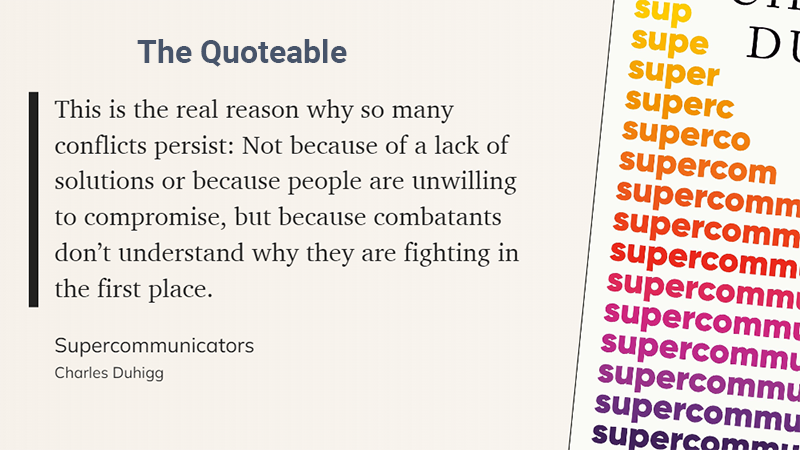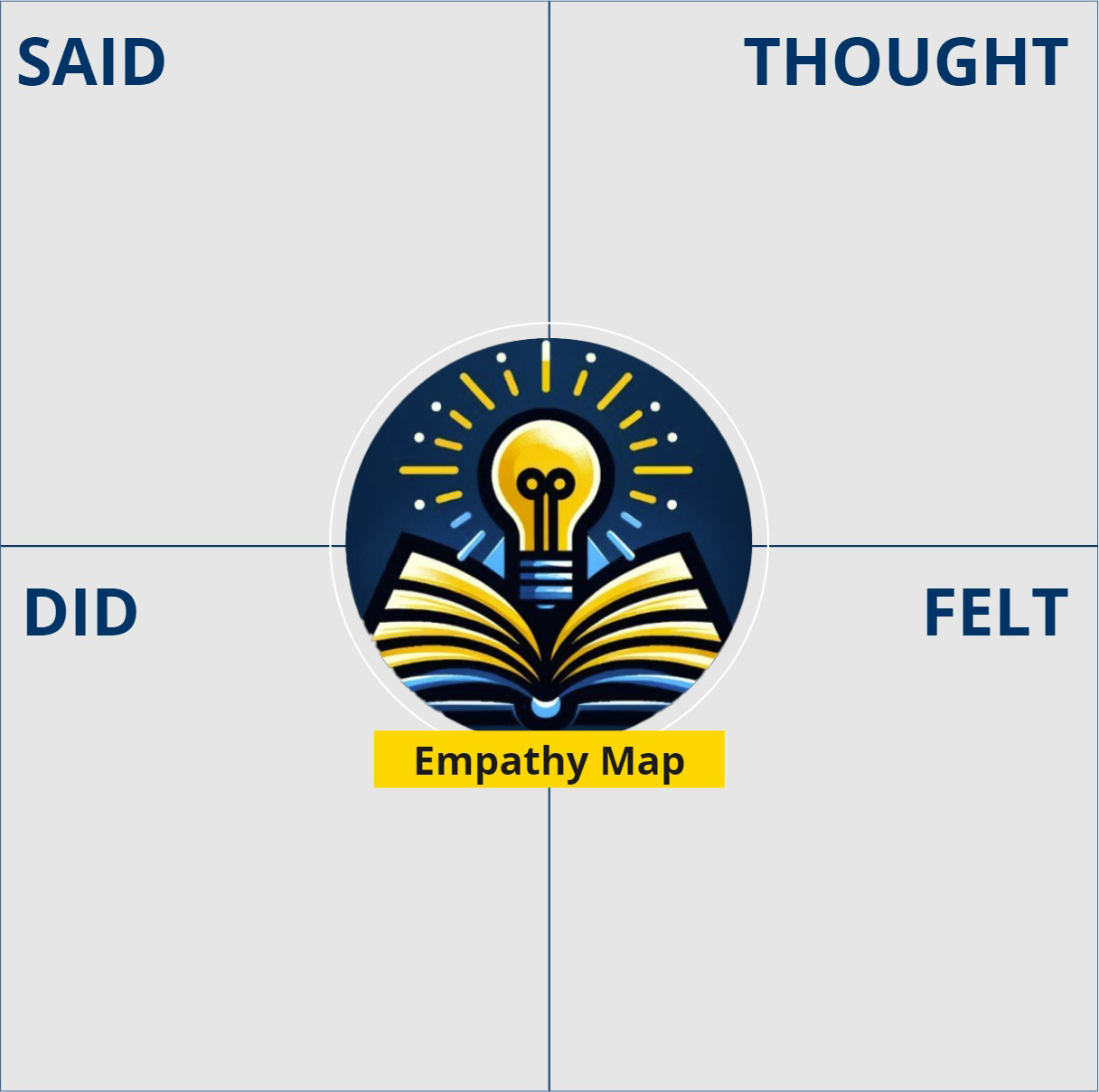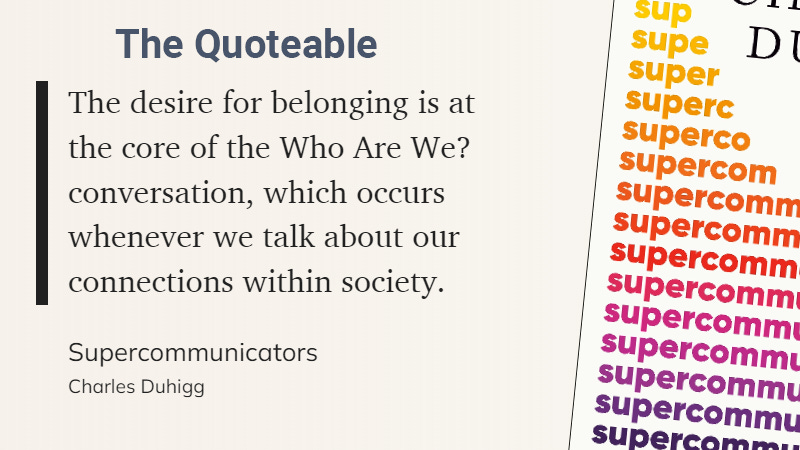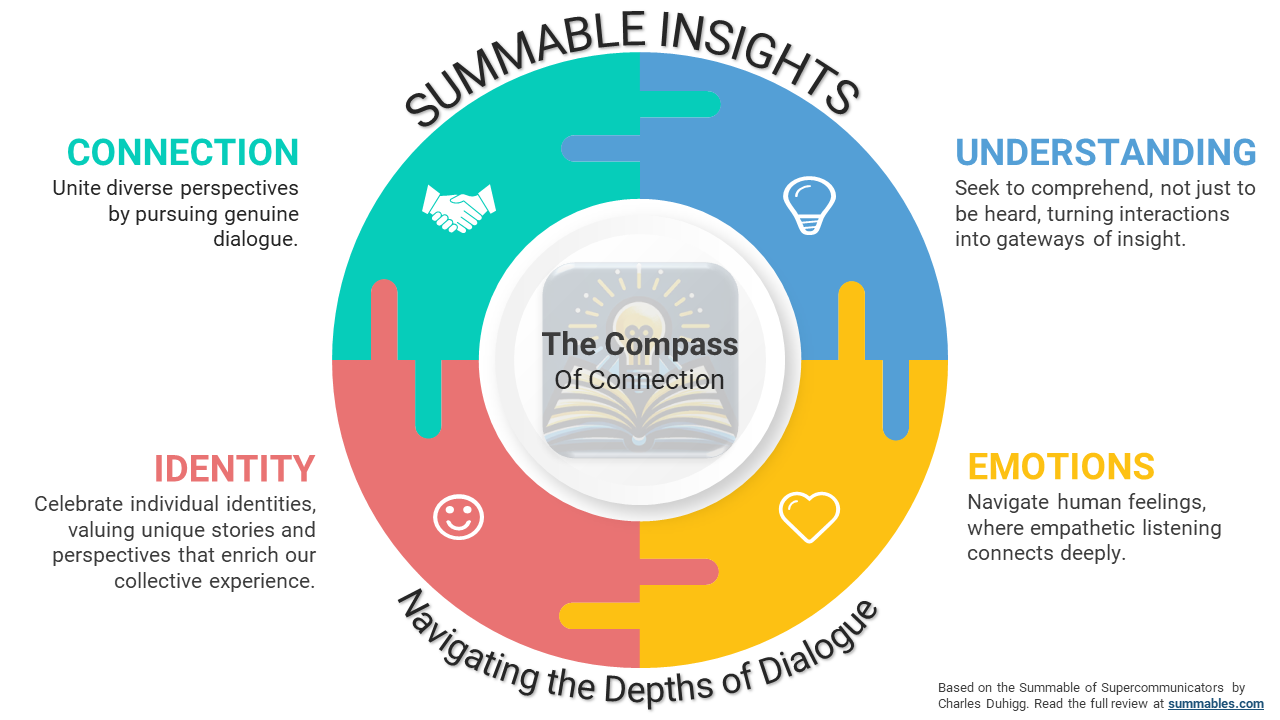S1 E1: Supercommunicators
A Summable review of the book Supercommunicators by Charles Duhigg
Supercommunicators, written by Charles Duhigg, offers a guide on elevating communication skills by harnessing empathy, understanding diverse perspectives, and engaging with the emotional and social dimensions of conversations.
In the below four Summables, you'll discover how Supercommunicators masterfully outlines strategies for becoming adept in the art of conversation across various contexts—ranging from professional negotiations to personal discussions.
Part 1: The Art of Connection
Part 2: Unveiling the Core of Conversations
Part 3: The Emotional Pulse of Communication
Part 4: Bridging Identities in Conversation
Together, these segments offer a comprehensive framework for understanding and improving communication in all aspects of life. Let’s dive in!
What is a Summable? It's a distilled essence of wisdom designed to navigate the oceans of information and insights with a compass of clarity and creativity.
Part 1: The Art of Connection
The Essentials
Supercommunicators shows that effective communication skills are learned, not innate. It emphasizes authenticity, empathy, and understanding in communication as a two-way street essential for meaningful connections across personal and professional spheres. The first part of the book showcases how recognizing and adapting to various conversation types—practical, emotional, and social—can enhance our ability to persuade, react, and engage with others.
The Summable
Step into the world of Felix Sigala, an FBI negotiator, skilled in high-stakes communication. In the corridors of power and crisis, Felix navigates the complex web of human psychology with a blend of authenticity, empathy, and strategic insight. His story, as unfolded in Supercommunicators, is more than tactics; it's a journey into connection, understanding, and influence.
Felix's day might start with a crisis negotiation, where the stakes are life and death, but the principles he uses apply in the conference rooms and offices where we spend our days. Through his experiences, we learn that effective communication is far from innate; it is a skill honed through understanding, practice, and the genuine desire to see the world through another's eyes.
As Supercommunicators explore Felix's methods, it reveals the underlying structure of our interactions, categorizing conversations into three types—practical decision-making, emotional, and social—each requiring a unique approach yet bound by the common thread of empathy and clarity. Felix's approach to each conversation type demonstrates the power of recognizing the needs and emotions of others, whether it's negotiating a hostage release or navigating office dynamics.
Duhigg challenges us to see ourselves as potential supercommunicators, pushing us to step beyond our comfort zones, listen deeply, and engage with authenticity and empathy. He offers a road map for improving and transforming personal and professional relationships into meaningful connections.
As you learn about effective communication, you're reminded that the art of communication is the art of connection. It's a powerful skill that can change outcomes, build relationships, and influence decisions. Supercommunicators gives us the tools and insights to start this journey, encouraging us to become architects of understanding in a world that needs more connection.
From Insight to Impact: Practical Applications
Key Takeaways: The first section emphasizes the importance of genuine connection, listening, and empathy by:
Fostering genuine engagement with others
Practicing empathetic listening to understand others' perspectives and needs
Showing genuine interest and empathy in conversations
Recognizing and adapting to different types of conversations (decision-making, emotional, social) for effective communication
Valuing listening as much as speaking in interactions
Applying these principles involves being present, open, and sincerely engaged in conversations, striving to understand before being understood, and approaching every interaction with empathy and a willingness to connect on a deeper level.
The Hidden Gem
Understanding the type of conversation (decision-making, emotional, or social) can lead to deeper connections and more meaningful interactions.
Ideas in Action: Take a Perspective Walk
This exercise applies the core principles of this Summable, aiming to deepen your understanding of effective communication through empathy and active listening, fostering connections in your personal and professional life.
Objective: Practice seeing the world from another's perspective to enhance empathy and understanding.
Steps:
Preparation: Think of someone you interact with regularly but feel you may not fully understand or connect with (e.g., a coworker, a partner, neighbor).
The Walk: Go for a 30-minute walk alone and imagine seeing the world through this person's eyes. Consider their concerns, joy, and how they might perceive various situations differently than you.
Reflection: After your walk, jot down your insights and feelings. How has this exercise changed your perspective on this person?
Engagement: The next time you interact with this person, incorporate your newfound understanding into your communication. Notice any changes in the interaction?
Reflect & React
Recall a recent meaningful conversation. What type was it? How did it shape your interaction?
Think of a situation where communication failed. Could identifying the conversation type have changed the outcome?
How can you apply supercommunication principles in your next challenging conversation at work or home?
Part 2: Unveiling the Core of Conversations
The Essentials
Part 2 introduces the "What’s This Really About?" conversation, which uncovers the actual topics of interest and dialogue rules. These stories reveal that identifying the true nature of conversations and participants' underlying needs is crucial for effective communication.
The Summable
In a bustling office, where ideas clash and merge to create innovation, the story of effective communication reveals the intricate dance of conversations that underpins every decision and relationship.
Picture a high-stakes, anticipation-filled boardroom. Meet Alex, a leader known for her keen insight and unwavering commitment to the team's success. But today, Alex faces a challenge—navigating a crucial meeting that could define the future of her team’s project.
Enter the "What’s This Really About?" conversation. Alex uses this concept to cut through the surface tension and dive into the real issues. Imagine Alex reflecting on the lessons learned from her recent read of Supercommunicators. The stories, vibrant with the struggle for understanding and connection, serve as a beacon, illuminating the path through the complexities of human interaction.
Every word in the boardroom is part of a delicate negotiation for a shared vision and progress. Alex listens, not just to reply, but to understand, to uncover the conversation layers revealing the team's aspirations and concerns. By asking open-ended questions, Alex invites her colleagues into a space where dialogue flows freely and analytical and empathetic logic create profound solutions.
This meeting exemplifies the power of understanding conversations. It's a testament to successful outcomes coming from engaging, listening, and adapting strategies that foster mutual understanding and respect.
As the meeting ends, the team has rallied around a unified strategy and the essence of Supercommunicators is evident. It's a reminder that within every successful project, every innovation, lies the foundational skill of effective communication—navigating human interaction to uncover shared goals and forge paths to remarkable achievements.
From Insight to Impact: Practical Applications
Key Takeaways:
Every conversation is a negotiation to uncover mutual interests rather than winning
Effective communication requires identifying the subject of discussion and conversation rules
Asking open-ended questions and listening attentively are crucial for understanding and addressing the underlying needs and desires of all parties.
Adapting communication based on the audience's preferred logic—analytical or empathetic—enhances understanding and connection.
The Hidden Gem
Recognizing the difference between analytical reasoning (costs and benefits) and empathetic reasoning (similarities) can transform how we approach conversations and negotiations, leading to deeper understanding and better outcomes.
Ideas in Action: Healthcare Negotiation
In a hospital, an administrator negotiates with insurance companies on coverage policies. Using analytical reasoning, the administrator presents data on patient outcomes, costs, and benefits. By incorporating empathetic reasoning, the administrator shares patient stories, highlighting policy impact on patient care and recovery, bringing a human element into the negotiation. This combination of logical and empathetic approaches appeals to insurers' bottom line and social responsibility, leading to a favorable agreement benefiting patients and the provider.
Reflect & React
Consider a recent conversation that felt unsatisfactory. Would identifying the underlying negotiation have changed the outcome?
Reflect on a time when you changed your communication strategy mid-conversation. What prompted the change, and what was the result?
How can you apply the principles of "What’s This Really About?" in your next tough conversation for a better outcome?
Part 3: The Emotional Pulse of Communication
The Essentials
Part 3 introduces the "How Do We Feel?” conversation, emphasizing the power of engaging with and understanding emotions in conversations. It details how tuning into emotional cues and fostering genuine conversations can deepen interpersonal connections in personal and professional settings.
The Summable
A transformative journey begins in a busy hedge fund office. Here, the art of communication takes center stage, not through numbers, but through the warm, pulsating rhythm of human emotions.
Imagine Sarah, a seasoned hedge fund manager with a sharp analysis and focus. Yet, beneath her composed exterior lies a quest for a deeper connection with her team; a desire to lead not just with her mind, but also with her heart. She engages in deep listening, a revelation that promises to change how Sarah and her team navigate the high-stakes world of finance.
Sarah introduces a novel approach that transforms the office into a human connection laboratory. The narrative highlights that true communication goes beyond spoken words; it's an intricate dance of emotional cues and responses. Sarah learns to tune into these silent signals, discovering the power of empathy, vulnerability, and the contagious nature of emotions. It's a journey of shedding superficial conversation layers to delve into genuine feelings, fostering a profound understanding and connection that transcends professional boundaries.
Far from a gut reaction, this story vividly explains the science behind emotional communication. From the psychological foundations of empathy to the role of vulnerability in building bridges between souls, Sarah and her team embark on a rewarding journey. They realize that emotionally connected conversations lead to more meaningful, satisfying interactions, enriching their professional lives and personal well-being.
Sarah and her team reshape professional interactions in the hedge fund office, showing the power of embracing humanity at work. By listening deeply and responding to emotional undercurrents, we can forge connections that enhance our professional engagements and enrich our lives beyond the office.
From Insight to Impact: Practical Applications
Key Takeaways:
Emotions play a pivotal role in communication, influencing what we say and how we're heard
Listening with empathy and responding to emotional cues enhances understanding and connection
Discussing feelings openly and vulnerably can lead to deeper interactions
Emotional intelligence is crucial for effective communication and can be developed through practice and awareness
The Hidden Gem
The magic of discussing feelings creates a reciprocal cycle of understanding and empathy that deepens connections.
Ideas in Action: The Empathy Mapping Session
This exercise applies the core principles of this Summable, aiming to deepen your understanding of the role emotions play in effective communication.
Objective: Deepen understanding and empathy by considering and discussing the emotions and perspectives of others in a specific scenario.
Steps:
Choose a Scenario: Pick a recent emotional scenario at work. For example, a disagreement, a performance review, or a project kickoff meeting.
Create an Empathy Map: Draw a simple chart with four quadrants labeled "Said," "Thought," "Felt," and "Did." Use this map to analyze the perspectives of different participants in the scenario. For each person (including yourself), fill in:
What they said in the situation.
What they might have thought but didn’t say.
How they felt during the interaction.
What they did as a result of their thoughts and feelings.
Reflect and Discuss: If doing this exercise as a team, share your empathy maps and discuss the insights gained:
Were there any surprises about others' thoughts or feelings?
How did understanding these perspectives change your view of the situation?
How will this understanding influence your approach to similar situations in the future?
Outcome: This exercise helps participants understand others' perspectives, fostering a deeper understanding of the emotional landscapes that play into workplace interactions. By considering not just what was said but also the unspoken thoughts and feelings, professionals can develop a nuanced approach to communication, enhancing empathy and emotional intelligence in their interactions.
Reflect & React
When did you last feel truly heard in a conversation? What emotional cues facilitated that feeling?
Can you identify a recent discussion where acknowledging the emotional undercurrents could have led to a better outcome?
How can you approach tough conversations differently, considering the power of emotional communication?
Part 4: Bridging Identities in Conversation
The Essentials
Part 4 introduces the "Who Are We?” conversation, emphasizing embracing differences for authentic interactions. It presents strategies like motivational interviewing and inclusive team-building to foster respect and understanding across diverse perspectives, advocating for environments that value rather than just tolerate diversity.
The Summable
In a global corporation, where diverse cultures and ideas intersect, our final Summable invites us into a story of a diverse team tackling vaccine hesitancy worldwide. It's a chance to bridge worlds and turn division into unity.
Meet Joey, a team leader committed to making a difference in lives. Joey and his team navigate the delicate intricacies of social identities, each member bringing their perspectives, biases, and backgrounds. It's a microcosm of the world, where differences often divide, but here, they seek to unite.
Through the tenets of belonging, we journey with Joey’s team as they foster an environment of recognition, acceptance, and celebration of differences. From medical offices to team meetings, the narrative unveils the transformative power of empathy and open-mindedness. As the team delves into motivational interviewing and inclusive activities, they discover the strength in their diversity, turning contrasting views into understanding and respect.
Joey’s team story shows how acknowledging multifaceted identities can revolutionize conversations and relationships. It champions the intentional cultivation of spaces where diversity is valued, and every voice contributes to a richer dialogue.
The final part of Supercommunicators argues for embracing our differences as bridges to deeper connection and understanding. Through Joey and his team's challenges and victories, we see a roadmap for navigating the complexities of identity in our interactions. It's a call to action to build a world where diversity is celebrated as a source of strength, enriching our professional environments and human connection.
From Insight to Impact: Practical Applications
Key Takeaways:
Social identities deeply influence interactions and perceptions
Understanding and bridging differences is essential for effective communication
Motivational interviewing can address complex issues by respecting diverse perspectives
Creating inclusive environments encourages empathy and connection
The Hidden Gem
The concept of "Who Are We?" conversations acknowledges and leverages our identities to foster understanding and connection, transforming communication.
Ideas in Action: Motivational Interviewing
Motivational interviewing is a counseling approach to elicit and strengthen motivation for change. It's grounded in empathetic and calm communication, aiming to help individuals explore and resolve ambivalence toward change. Unlike traditional advice-giving, it encourages individuals to find their own reasons for making changes, based on their values and interests.
Here's a closer look at the key principles:
Expressing Empathy: By listening and being nonjudgmental, the interviewer creates a supportive environment where individuals feel understood and accepted.
Developing Discrepancy: The interviewer helps individuals recognize the gap between their current behaviors and their broader values or goals, highlighting the benefits of change.
Rolling with Resistance: Instead of opposing direct resistance to change, motivational interviewing involves accepting and exploring the individual's reasons for resistance as a normal part of the change process.
Supporting Self-Efficacy: The approach emphasizes autonomy and ability to make changes, encouraging belief in one's own ability to change.
Motivational interviewing is effective in addressing complex issues because it respects diverse perspectives and focuses on eliciting internal motivation instead of imposing external pressure or judgment. This approach allows for an insightful understanding of an individual's hesitations or concerns, providing a pathway for resolution.
Reflect & React
How can "Who Are We?" conversations enhance understanding and connection in daily interactions?
Reflect on a time when acknowledging someone's social identity could have improved a conversation or outcome. How might you approach similar situations differently in the future?
Consider creating more inclusive environments in your personal and professional life that honor and celebrate diverse identities.
Final Thoughts and Action Plan
Thanks for joining Summables in this journey of Supercommunicators by Charles Duhigg. We hope you have enjoyed these four Summables. If you would like to explore this topic further, we’ve included an action plan based on how you can apply the principles to improve your interactions.
Action Plan:
Reflection: Start with self-reflection. Identify areas in your communication that could benefit from more empathy or understanding.
Practice: Engage in active listening with friends, family, or colleagues to hone your ability to truly hear and understand others.
Learning: Explore emotional intelligence and social identity to broaden your perspective.
Application: Implement what you've learned in real-life scenarios, focusing on the emotional and social dimensions of conversations.
Evaluation: After each conversation, reflect on what went well and areas for improvement.
Sharing: Share your experiences and learnings to foster a culture of impactful communication in your community or workplace.
As you explore the insights and strategies in our Summable, you're gaining tools for personal and professional growth and unlocking new possibilities in how we connect, understand, and interact. But why stop at your own transformation?
Share this Summable with a friend or colleague. Why? Because communication is the fabric of our relationships, and by sharing these insights, you're contributing to a larger culture of understanding, empathy, and genuine connection. Imagine a world where every conversation is an opportunity for growth and connection. By sharing, you're not just passing along information; you're igniting a ripple of positive change in your networks and communities.



